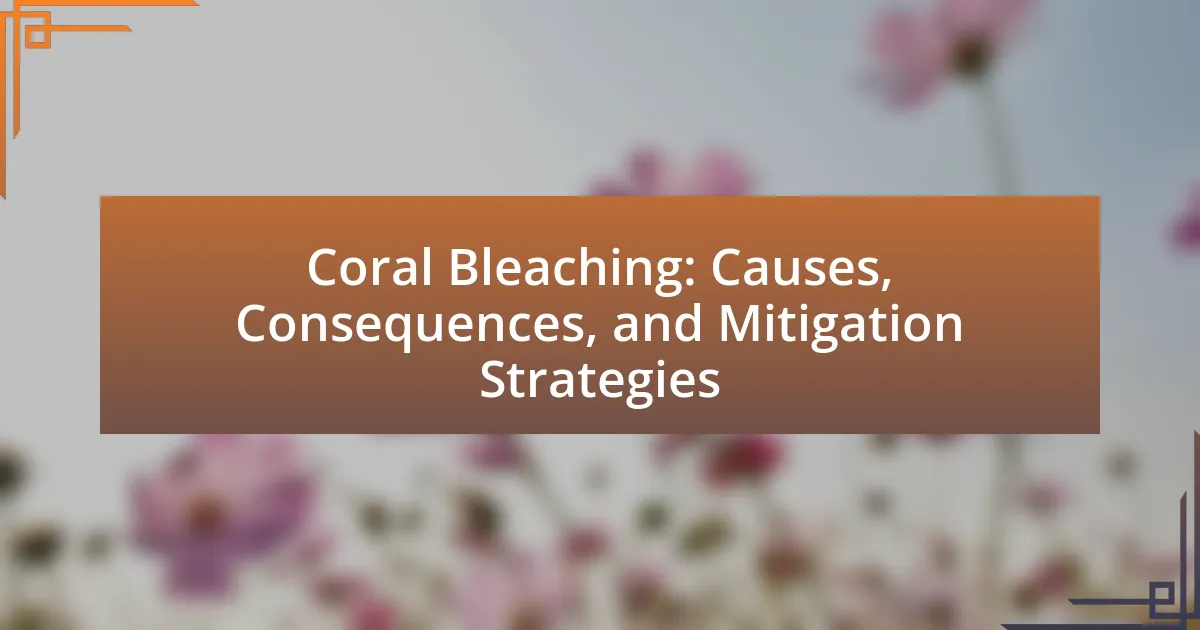Coral bleaching is a critical environmental phenomenon characterized by the loss of color in corals due to stress factors such as elevated sea temperatures, pollution, and changes in water chemistry. This process involves the expulsion of symbiotic algae known as zooxanthellae, which are essential for coral health and provide vital nutrients. The article explores the causes of coral bleaching, including climate change and human activities, and discusses its significant ecological impacts, such as the decline in marine biodiversity and the disruption of local economies reliant on coral reefs. Additionally, it outlines potential mitigation strategies, including the establishment of marine protected areas and restoration ecology, aimed at preserving coral ecosystems and enhancing their resilience against future stressors.

What is Coral Bleaching?
Coral bleaching is a phenomenon where corals lose their vibrant colors and turn white due to stress, primarily caused by elevated sea temperatures, pollution, and changes in water chemistry. This stress leads to the expulsion of symbiotic algae called zooxanthellae, which provide corals with essential nutrients and their coloration. Research indicates that when water temperatures rise by just 1-2 degrees Celsius above normal, corals can experience bleaching, which can lead to their death if stressful conditions persist.
How does Coral Bleaching occur?
Coral bleaching occurs when corals expel the symbiotic algae called zooxanthellae that live within their tissues. This expulsion is primarily triggered by stress factors such as elevated sea temperatures, increased solar radiation, and changes in water quality. When corals lose these algae, they not only lose their color but also a significant source of nutrition, leading to weakened health and increased mortality rates. Research indicates that a temperature rise of just 1-2 degrees Celsius above the normal range can initiate bleaching events, as documented in studies by the National Oceanic and Atmospheric Administration (NOAA).
What role do zooxanthellae play in coral health?
Zooxanthellae are crucial for coral health as they provide essential nutrients through photosynthesis. These symbiotic algae live within coral tissues and convert sunlight into energy, which supports coral growth and reproduction. In fact, zooxanthellae contribute up to 90% of the energy required by corals, making them vital for maintaining coral reef ecosystems. Their presence also enhances the coral’s ability to build calcium carbonate structures, which are fundamental for reef formation. Without zooxanthellae, corals would struggle to survive, leading to weakened reefs and increased susceptibility to stressors such as temperature changes and pollution.
How do environmental stressors trigger coral bleaching?
Environmental stressors trigger coral bleaching primarily by causing the expulsion of symbiotic algae, known as zooxanthellae, from coral tissues. Elevated sea temperatures, often exceeding 1-2 degrees Celsius above normal, lead to thermal stress, which disrupts the photosynthetic process of these algae. When stressed, corals react by ejecting the zooxanthellae, resulting in a loss of color and essential nutrients, as these algae provide up to 90% of the energy corals need to survive. Additionally, factors such as ocean acidification, pollution, and changes in salinity further exacerbate this stress, contributing to the bleaching phenomenon. Studies indicate that coral reefs can experience significant bleaching events when temperatures remain elevated for prolonged periods, highlighting the critical relationship between environmental conditions and coral health.
Why is Coral Bleaching a significant environmental issue?
Coral bleaching is a significant environmental issue because it leads to the loss of biodiversity and disrupts marine ecosystems. When corals expel the symbiotic algae living in their tissues due to stressors like rising sea temperatures, they lose their color and essential nutrients, which can result in coral death. According to the National Oceanic and Atmospheric Administration (NOAA), approximately 30% of coral reefs worldwide have been affected by bleaching events, which not only threatens the corals themselves but also the myriad of marine species that depend on these habitats for survival. The decline of coral reefs can have cascading effects on fisheries, tourism, and coastal protection, highlighting the urgent need for conservation efforts.
What are the ecological impacts of Coral Bleaching?
Coral bleaching significantly disrupts marine ecosystems by causing the loss of coral cover, which serves as habitat for numerous marine species. When corals expel the symbiotic algae (zooxanthellae) that provide them with energy and color due to stressors like temperature rise, they become more susceptible to disease and mortality. This decline in coral health leads to reduced biodiversity, as many fish and invertebrate species rely on coral reefs for shelter and food. Studies indicate that coral reefs support about 25% of all marine life, highlighting their critical role in maintaining ecological balance. Furthermore, the degradation of coral reefs can impact coastal protection, leading to increased erosion and vulnerability of coastal communities.
How does Coral Bleaching affect marine biodiversity?
Coral bleaching significantly reduces marine biodiversity by causing the loss of coral reefs, which serve as critical habitats for numerous marine species. When corals expel the symbiotic algae (zooxanthellae) that provide them with color and nutrients due to stress from temperature increases, pollution, or other factors, the reefs become less hospitable. This loss of habitat leads to declines in fish populations and other marine organisms that rely on coral ecosystems for shelter and food. Research indicates that coral reefs support about 25% of all marine species, highlighting their importance in maintaining biodiversity. The decline of these ecosystems can result in the extinction of species that depend on them, further destabilizing marine environments.

What are the main causes of Coral Bleaching?
The main causes of coral bleaching are elevated sea temperatures, ocean acidification, and pollution. Elevated sea temperatures, often resulting from climate change, can cause corals to expel the symbiotic algae (zooxanthellae) that provide them with nutrients and color, leading to bleaching. Research indicates that a temperature increase of just 1-2 degrees Celsius above normal can trigger this process. Ocean acidification, caused by increased carbon dioxide absorption, reduces the availability of carbonate ions necessary for coral growth and health. Additionally, pollution from agricultural runoff, sewage, and plastic waste can stress coral ecosystems, making them more susceptible to bleaching events. These factors collectively threaten coral reefs, which are vital to marine biodiversity and coastal protection.
How do climate change and temperature fluctuations contribute to Coral Bleaching?
Climate change and temperature fluctuations significantly contribute to coral bleaching by causing elevated sea temperatures that stress coral ecosystems. When water temperatures rise by just 1-2 degrees Celsius above normal levels, corals expel the symbiotic algae (zooxanthellae) that provide them with nutrients and color, leading to bleaching. Research indicates that prolonged exposure to elevated temperatures can result in widespread coral mortality; for instance, the Great Barrier Reef experienced severe bleaching events in 2016 and 2017, with over 50% of its corals affected. This phenomenon is directly linked to climate change, as increased greenhouse gas emissions lead to global warming and subsequent ocean temperature rises.
What temperature thresholds lead to Coral Bleaching?
Coral bleaching occurs when sea temperatures rise above 1 to 2 degrees Celsius above the normal maximum temperature for prolonged periods, typically lasting more than four weeks. This temperature threshold disrupts the symbiotic relationship between corals and the algae (zooxanthellae) that live within their tissues, leading to the expulsion of these algae and resulting in the loss of color and vital nutrients for the corals. Studies indicate that sustained temperatures of 30 degrees Celsius or higher can significantly increase the risk of bleaching events, as evidenced by the widespread coral bleaching observed during the 2016 global bleaching event, where ocean temperatures reached unprecedented levels.
How does ocean acidification impact coral reefs?
Ocean acidification negatively impacts coral reefs by reducing the availability of carbonate ions, which are essential for coral calcification. As atmospheric CO2 levels rise, more CO2 dissolves in ocean water, leading to lower pH levels and increased acidity. This change in chemistry hampers the ability of corals to build their calcium carbonate skeletons, making them more vulnerable to erosion and less able to recover from stressors such as bleaching. Studies indicate that a decrease in pH by 0.3 units can reduce calcification rates in corals by up to 50%, highlighting the significant threat posed by ocean acidification to coral reef ecosystems.
What human activities exacerbate Coral Bleaching?
Human activities that exacerbate coral bleaching include climate change, pollution, overfishing, and coastal development. Climate change leads to increased sea temperatures, which is the primary trigger for coral bleaching, as corals expel the symbiotic algae that provide them with nutrients and color. Pollution from agricultural runoff and sewage introduces harmful nutrients and toxins into marine environments, further stressing coral ecosystems. Overfishing disrupts the balance of marine life, leading to an increase in algae that can smother corals. Coastal development, including construction and dredging, damages coral habitats and increases sedimentation, which can block sunlight essential for coral health. These activities collectively contribute to the decline of coral reefs globally, as evidenced by studies showing significant coral loss in areas affected by these human pressures.
How does pollution affect coral ecosystems?
Pollution negatively impacts coral ecosystems by introducing harmful substances that lead to coral bleaching and degradation. Specifically, pollutants such as nutrients from agricultural runoff can cause algal blooms, which block sunlight and reduce the ability of corals to photosynthesize. Additionally, heavy metals and plastics can directly harm coral health, leading to increased susceptibility to disease. Research indicates that areas with high nutrient pollution experience a significant decline in coral cover, with studies showing that nutrient enrichment can reduce coral growth rates by up to 50%.
What is the impact of overfishing on Coral Bleaching?
Overfishing significantly contributes to coral bleaching by disrupting the ecological balance of marine environments. The removal of key fish species, such as herbivores that graze on algae, leads to algal overgrowth on coral reefs. This overgrowth can smother corals, reducing their ability to receive sunlight and perform photosynthesis, which is essential for their survival. Studies indicate that areas with high fishing pressure often experience increased algal cover and subsequent coral bleaching events. For instance, research published in “Marine Ecology Progress Series” highlights that overfishing of herbivorous fish correlates with a decline in coral health and resilience, exacerbating bleaching incidents.

What are the consequences of Coral Bleaching?
Coral bleaching leads to the loss of symbiotic algae, resulting in decreased coral health and increased mortality rates. When corals expel the algae, they lose their color and essential nutrients, making them more susceptible to disease and reducing their reproductive success. Studies indicate that severe bleaching events can lead to up to 90% mortality in affected coral populations, significantly disrupting marine ecosystems and the biodiversity they support. Additionally, the decline of coral reefs impacts fisheries and tourism, which are vital to many coastal economies, further illustrating the extensive consequences of coral bleaching.
How does Coral Bleaching affect local economies?
Coral bleaching negatively impacts local economies primarily by reducing tourism revenue and fisheries productivity. When coral reefs bleach, they lose their vibrant colors and biodiversity, making them less attractive to tourists who contribute significantly to local economies through activities like snorkeling and diving. For instance, the Great Barrier Reef, which supports a tourism industry worth approximately $6 billion annually, has seen declines in visitor numbers due to coral bleaching events. Additionally, local fisheries suffer as bleached reefs provide fewer habitats for fish, leading to decreased fish populations and lower catches for local fishermen. This economic downturn can result in job losses and reduced income for communities reliant on these industries.
What is the impact on tourism in coral reef regions?
The impact on tourism in coral reef regions is significant, as healthy coral reefs attract millions of visitors annually for activities such as snorkeling, diving, and eco-tourism. According to the National Oceanic and Atmospheric Administration (NOAA), coral reefs contribute approximately $375 billion globally to tourism and fisheries, highlighting their economic importance. However, coral bleaching, driven by climate change and pollution, leads to the degradation of these ecosystems, resulting in decreased tourist visits and revenue. For instance, the Great Barrier Reef in Australia experienced a decline in tourism revenue by over $1 billion following severe bleaching events in recent years. This demonstrates that the health of coral reefs directly correlates with the viability and profitability of tourism in these regions.
How does Coral Bleaching influence fisheries and livelihoods?
Coral bleaching negatively impacts fisheries and livelihoods by reducing fish populations and disrupting marine ecosystems. When coral reefs bleach, they lose their vibrant colors and the symbiotic algae that provide essential nutrients, leading to decreased habitat for fish species. This decline in fish populations directly affects local fisheries, which rely on healthy reefs for sustainable catches. For instance, studies indicate that regions experiencing significant coral bleaching can see fish biomass decline by up to 50%, severely impacting the livelihoods of communities dependent on fishing. Additionally, the loss of biodiversity and ecosystem services provided by coral reefs can lead to economic instability for coastal communities, as they face reduced income from fishing and tourism activities linked to healthy coral ecosystems.
What are the long-term ecological consequences of Coral Bleaching?
Coral bleaching leads to significant long-term ecological consequences, primarily the loss of biodiversity in marine ecosystems. When corals expel the symbiotic algae (zooxanthellae) that provide them with nutrients and color, they become more susceptible to disease and mortality, which disrupts the entire reef ecosystem. Research indicates that coral reefs support approximately 25% of all marine species, and their degradation can result in the decline of fish populations and other marine organisms that rely on reefs for habitat and food. Additionally, the loss of coral reefs affects coastal protection, leading to increased erosion and vulnerability of coastal communities to storms and rising sea levels.
How does Coral Bleaching alter marine ecosystems?
Coral bleaching significantly alters marine ecosystems by disrupting the symbiotic relationship between corals and the algae (zooxanthellae) that live within them. When corals experience stress from factors such as increased sea temperatures, they expel these algae, leading to a loss of color and essential nutrients. This disruption results in decreased coral growth rates, reduced reproductive success, and increased susceptibility to disease. Consequently, the loss of coral cover diminishes habitat complexity, which negatively impacts the diverse marine species that rely on coral reefs for shelter and food. Studies indicate that coral reefs support approximately 25% of all marine life, highlighting the critical role they play in maintaining biodiversity within marine ecosystems.
What are the potential outcomes for coral species diversity?
The potential outcomes for coral species diversity include significant declines in species richness and shifts in community composition. Research indicates that climate change, particularly rising sea temperatures, leads to coral bleaching, which can result in the loss of sensitive coral species and favor more resilient species. A study published in “Nature” by Hughes et al. (2017) found that coral reefs have experienced a 50% decline in species diversity over the past 30 years due to environmental stressors. Additionally, habitat degradation and ocean acidification further threaten coral ecosystems, potentially leading to reduced genetic diversity and increased vulnerability to diseases.
What strategies can be implemented to mitigate Coral Bleaching?
To mitigate coral bleaching, strategies such as reducing greenhouse gas emissions, establishing marine protected areas, and promoting coral restoration can be implemented. Reducing greenhouse gas emissions addresses the primary cause of rising ocean temperatures, which leads to bleaching; for instance, the Intergovernmental Panel on Climate Change (IPCC) emphasizes that limiting global warming to 1.5 degrees Celsius is crucial for coral health. Establishing marine protected areas helps to safeguard coral ecosystems from overfishing and pollution, allowing them to recover and thrive. Additionally, promoting coral restoration through techniques like coral gardening and selective breeding can enhance resilience against stressors, as demonstrated by successful projects in the Caribbean that have increased coral cover by up to 50%.
How can marine protected areas help in coral conservation?
Marine protected areas (MPAs) can significantly aid in coral conservation by providing a refuge from human activities that harm coral ecosystems. MPAs restrict activities such as overfishing, pollution, and coastal development, which are known to contribute to coral degradation. Research indicates that MPAs can enhance coral resilience by allowing ecosystems to recover and maintain biodiversity, which is crucial for coral health. For instance, a study published in “Nature” by Edgar et al. (2014) found that well-managed MPAs can lead to a 20% increase in coral cover compared to unprotected areas. This evidence supports the effectiveness of MPAs in fostering healthier coral populations and mitigating the impacts of climate change and other stressors.
What role does restoration ecology play in mitigating Coral Bleaching?
Restoration ecology plays a crucial role in mitigating coral bleaching by enhancing the resilience of coral ecosystems through targeted interventions. These interventions include the restoration of degraded coral habitats, the reintroduction of resilient coral species, and the management of local stressors such as pollution and overfishing. For instance, studies have shown that restoring coral reefs can increase their ability to withstand temperature fluctuations, which are a primary cause of bleaching. Additionally, successful restoration projects have demonstrated that healthy coral populations can recover more effectively from bleaching events, thereby maintaining biodiversity and ecosystem services.
What actions can individuals take to combat Coral Bleaching?
Individuals can combat coral bleaching by reducing their carbon footprint, supporting sustainable seafood practices, and participating in local conservation efforts. Reducing carbon emissions can be achieved through actions such as using public transportation, conserving energy at home, and minimizing waste. Supporting sustainable seafood involves choosing fish that are caught or farmed in environmentally friendly ways, which helps maintain healthy marine ecosystems. Additionally, individuals can engage in local conservation initiatives, such as beach clean-ups and coral restoration projects, which directly contribute to the health of coral reefs. These actions are crucial as coral bleaching is primarily driven by climate change and pollution, with studies indicating that reducing greenhouse gas emissions can significantly mitigate its impacts.
How can sustainable practices contribute to coral health?
Sustainable practices can significantly enhance coral health by reducing stressors that contribute to coral bleaching. For instance, implementing marine protected areas helps to limit overfishing and habitat destruction, allowing coral ecosystems to recover and thrive. Additionally, sustainable tourism practices minimize pollution and physical damage to coral reefs, which are critical for maintaining biodiversity and ecosystem resilience. Research indicates that areas with sustainable management show higher coral cover and diversity, as evidenced by a study published in “Marine Ecology Progress Series” by Edgar et al. (2014), which found that well-managed reefs had 50% more coral cover compared to poorly managed ones.
What are some effective ways to raise awareness about Coral Bleaching?
Effective ways to raise awareness about coral bleaching include educational campaigns, community engagement, and social media outreach. Educational campaigns can be implemented in schools and community centers to inform people about the causes and impacts of coral bleaching, utilizing visual aids and interactive activities to enhance understanding. Community engagement initiatives, such as beach clean-ups and coral restoration projects, can foster a sense of responsibility and connection to marine ecosystems. Social media outreach leverages platforms like Instagram and Twitter to share impactful images and facts about coral bleaching, reaching a broader audience and encouraging public discourse. Research indicates that visual storytelling significantly increases engagement and retention of information, making these methods particularly effective in raising awareness.
